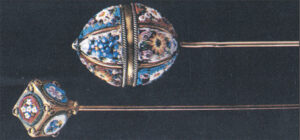
Marjorie McLaren of Anchorage, Alaska, tells us, “June’s What Is It? shows two micro mosaic hat pins likely made in Italy in the mid 19th to early 20th century. Around that time wealthy people would take a Grand Tour of Europe – especially Italy – and would bring back colorful mementos such as these hat pins, made with tiny colorful pieces of glass and often showing flowery scenes. Hat pins had their heyday during this period as hairstyles were extravagantly bouffant and hats were equally showy. The era of the bonnet with ties had ended, to be replaced by hat pins of 8-12” long to anchor hats to one’s hair. Some governments tried to restrain the purchase of such frivolities by women and for a time limited their purchase to only two days a year. The term “pin money” (meaning money saved for special little purchases) arose during this time. As fashions changed and women attained more individual freedoms (such as travel on public transportation), the potential use of hairpins to protect oneself from “gropers” became an issue. By the time the 19th Amendment gave voting rights to women in 1920, styles and hairstyles had changed and hat pins were no longer necessary.”
What fun to have all of these details about our What Is It. Here is what we know about these hatpins: The hatpins pictured are mosaic hatpins. They are fashioned of tiny pieces of colored glass and were probably made between 1850 and 1870. The cube, 3/8 inch on each side, has 6 floral designs, the ball 12.
Also venturing guesses were Jean Kropp of Westminster, Colorado and Annette Glaess, also of Westminster, Colorado. Elizabeth Puls of Boulder adds, “They appear to be a sort of filigreed pattern made of various colored stones, glass or some real gemstones. Gold banding is on the heads of the pins and the stems. (If not gold, maybe brass.) I feel the large one may have come from Russia because it bears a slight resemblance to a Fabrege egg.” Terry Cook of Fort Morgan, Colorado tells us these “pinballs” were kept close by to secure caps to the hair and hold neckerchiefs in place among other uses.
Thank you all for your guesses. You make the What Is Its much more interesting!















Follow Us